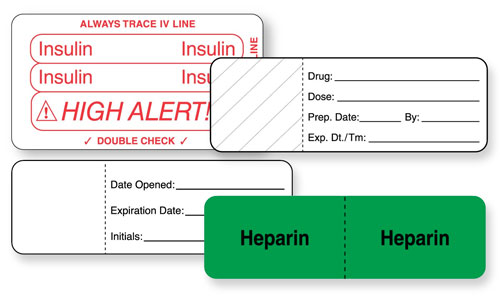Medication administration ranks as one of the most challenging patient safety issues for healthcare organizations. And when dispensing medications, that process often includes IV therapy. In fact, an estimated 90 percent of hospitalized patients in the U.S. receive an IV therapy for medications and other fluids at some point during their stay. But even with technology such as smart pumps, medication dispensing errors associated with infusions are common. To illustrate, a multisite study conducted by Schnock et. al. found 60% of infusions contained one or more errors and nearly two thirds of those errors occurred when labeling protocols were violated. It’s one of the reasons why labeling IV tubing is so important.
Why Is Labeling IV Tubing So Important?
Labeling IV tubing, especially when high alert medications are involved, reduces the chance of errors in medication administration.
From racing through an extremely busy day, to not understanding the guidelines and more, there are numerous reasons why protocols are violated. That’s why defining a consistent approach, including training your staff on how to properly label an IV line, can increase compliance and elevate patient safety.
How Do You Label An IV Line?
IV Line labels perform a variety of different functions that guide care delivery. How to label an IV line label properly incorporates those various functions. For example,
Using IV Line Labels For Medication Dispensing
There are several medication dispensing steps that IV line labels help to manage.
- Line identification - an IV line label identifies the route of medication dispensing.
- Line identification is especially important when multiple lines are involved. In fact, as the amount of lines increases, so does the potential for errors.
- Medication type - An IV line label identifies the medication that’s being dispensed. Dosage - throughout the duration of the IV, the dosage required may change.
Using IV Line Labeling For Change Reminders
In addition, IV line labels also guide the timing of tubing changes. IV tubing requires regular changing. Depending upon the type of infusion, the timing ranges from four hours for blood administration to 72 - 96 hours for piggyback or secondary tubing.
Proper IV Line Labeling
And to ensure effective administration, these are the IV line labeling steps you should follow.
- To prevent mix ups - label the IV line by placing the label at the top of the line and closest to the insertion point on the patient side. Place labels so they don’t interfere with administering medication or the injection port.
- When dispensing medications from an IV bag - add a medication flag to that line to further highlight the medication. Plus, to ensure proper dosing during shift changes, make sure the IV line label Dose Line contains the dose the patient is receiving.
- Changing IV tubing at the appropriate time intervals - use a change reminder label. You can manually fill in the time when a change is required or use labels with specific messages that show the change day or the allowed time duration.
What Information Should Be Recorded On An IV Line Label?
In addition to applying the label properly, an IV line label should contain specific lines of information. Each line is designed to help inform care and ensure adherence to the Five Rights Of Medication Administration. This includes:
- Drug Name and Concentration
- Dose
- Prep Time
- Change Date/Time
- Initials
- Alerts
Although there are essential data points that an IV line label should contain, establishing standards that are used throughout the hospital should dictate how that information is presented. A lack of consistency and formats causes confusion among nurses, inaccurate data input or no input at all. This puts patients at risk and can result in possible Joint Commission violations.
Should You Use Colored Labels To Identify IV Tubing?
Another option to reduce IV tubing errors is through the use of colors. In fact, color coding may help trace an IV line from the bag to the point of insertion. But, using colors to identify IV tubing isn’t recommended by most healthcare professionals. For example, colors are typically used to differentiate a particular drug class, not just a product.
- Blue - opioids/narcotics
- Fluorescent red - neuromuscular blockers
- Yellow - induction agents
- Orange - tranquilizers
- Violet - vasopressors
- Green - anticholinergics
With a color code system, it becomes easy to observe the general information the color indicates rather than the specific details of the drug contained on the actual label. And when you are in a rush going from patient to patient, it amplifies the potential for a problem to surface.
Preventing IV Tubing Patient Safety Issues
Ensuring proper IV line labeling throughout the organization requires a collaborative effort between Value Analysis, Risk Management, Pharmacy and the Nursing staff. Plus, the importance of a consistent approach throughout the organization is crucial, especially as the trend of floating, temporary and traveling nurses increases.
These steps have contributed to developing an approach that works throughout the organization:
- Engaging the cross functional team to determine the similarity or differences in IV line labeling throughout the organization
- Collecting the various samples of IV line labels used throughout the facility
- Discussing drug names and how to handle generics
- Identifying gaps in the current processes, for example:
- Are all the lines on the IV line label necessary or should other lines be added
- Do you use an ASTM color system?
- How are date and time identified? For example, do you use regular time or military time? Is it consistent throughout the operation?
Once you have uncovered the key data points:
- Design a label that contains only the required lines, no more, no less
- Determine the IV line label size that best works and standardize it throughout your facility
Plus, build your program for the long haul allowing for expansion as necessary.
United Ad Label IV Tubing And Line Labels
Even with the complexities of processes, stakeholders and systems, there are steps you can take to ensure that IV tubing is labeled properly and enhance patient safety. United Ad Label has deep experience helping healthcare organizations develop and implement IV tubing and line label systems that make nurses jobs easier while increasing compliance and improving patient safety. Contact us to learn more.
